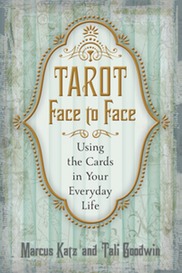Review by Stephanie Arwen Lynch

Tarot Face-To-Face: Using the Cards in Your Everyday Life by Tali Goodwin & Marcus Katz
Published by Llewellyn Publishing (September 2012 release)
ISBN: 978-0738733104
Llewellyn brings us another book on how to learn Tarot. I was delighted to receive an ARC (advanced reader copy). Overall, I do recommend this book. I have a few caveats that are based on tone rather than subject. I always have a knee jerk reaction to what I perceive as dogmatic phrasing. But, I also recognize that my perception may not be everyone else's.
This book proposes that a basic missed step in learning Tarot is the concept that symbols carry a range of meaning. They suggest that that "every symbol can really mean anything at all." While that is a pretty broad brush, I agree with this statement for the most part. I do think that there are symbols that have such commonly accepted meanings in our world today that it's difficult to look beyond that particular meaning. Goodwin et al goes on to discuss how we use symbols. One thing that stuck out was this statement:
Bridging an be defined as visually and/or intuitively connecting the symbols of the cards in a way that makes sense in the context of the reading.
This is definitely set up to be a workbook with exercises. The skills and exercises taught aren't always new but the systematic approach is one that I think will work quite well for most. The suggestion to get a journal to work through this book is an excellent one. I found myself wanting to have a journal handy as I read it. Some of my objections to this book are based on the tone and assumption that other ways of learning the Tarot are not valid or as effective. I very much liked their tone of not overanalyzing what information you get from the exercises. That is something I try to impart on my students. I'm always asking them to just learn to trust their gut. It's a hard thing to learn. No person or book or class is going to teach anyone that but maybe the repetition will.
The first two exercises dive right into doing readings which is another thing I emphasize with my students. Doing readings is the key to learning to read the Tarot. You can build and layer your toolbox of meanings as you go, but you do need to dive in. Goodwin & Katz are spot-on with this idea as far as I am concerned. This is how I was taught as well. Pick the deck up and start reading. You can liken it to the "jump in and swim method." I do acknowledge that picking up the deck can be as scary as being tossed into the deep end, but trust me, and Tarot Face to Face. You can do this. The first spread they recommend is one that uses sixteen cards.
A lot of what is in this book is not new in terms of concept. Goodwin et al have taken the information and given it better terms and a clearer direction than some other Tarot books with the same concept. There is the listing of key phrases for the Majors and key words for the minors that must be expected in a book geared towards beginners. An interesting technique was that they gave a key word for each suit and then a key word for each number or court card. So the same key word for nine (rest) would be related to the key word for that suit. The 9 of Pentacles would indicate a rest in resources while the 9 of Wands would indicate a rest in ambition. That's a great starting point as long as the student understands that starting points aren't stopping points. For me, I found it to be an interesting exercise to limit my own knowledge down to just the two words for each card.
One repetitive message is about learning to read the Tarot in layers. I found that what they called "installation" could also be said to be immersion. You just keep using the information in various ways to let it sinck into your brain. This is what occurs when someone goes into a country where they don't really know the language. Their brain has to adjust and learn what it hears.
I do recommend this book albeit with the caveat that there is no "One Way" to anything. If one exercise doesn't sit well, give it another try or two and then let it go. There's plenty of good in this book. I think it would be an asset to those learning as well as teaching Tarot.